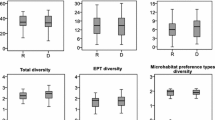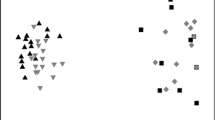Abstract
It has been hypothesised that freshwater pollution may favour the establishment of tolerant invaders at the expense of less-tolerant residents. To test this, this study capitalises on the aftermath of a farm pollution incident, a slurry discharge to a small British stream, which eliminated the resident macroinvertebrate assemblage. Stream transplant bioassay experiments at the discharge site revealed a higher pollution tolerance of the invasive amphipod Crangonyx pseudogracilis and the isopod Asellus aquaticus than that of the native amphipod Gammarus duebeni celticus and the invasive Gammarus pulex. A. aquaticus recolonised the stream up to the discharge point within days, followed by C. pseudogracilis, then G. pulex, with G. duebeni celticus undetected after a month. Values of a macroinvertebrate-derived biotic index of organic water quality, the Average Score Per Taxon (ASPT), gradually increased up to the discharge point in the 30 days following the incident. In a larger-scale survey (72 river and 12 pond sites), inclusion/exclusion of Gammarus spp. had no effect on ASPT values, while inclusion of C. pseudogracilis increased values, despite an assumed equivalence of these amphipods in the index. Pollution could facilitate the establishment of tolerant invaders, and this has implications for biomonitoring.





Similar content being viewed by others
References
Andrew, T. E., 1998. Biological indications of the current status of rivers and lakes in Northern Ireland. In Wilson, J. G. (ed.), Eutrophication in Irish waters. Royal Irish Academy, Dublin: 48–54.
Arbačiauskas, K., V. Semenchenko, M. Grabowski, R. S. E. W. Leuven, M. Paunovic, M. O. Son, B. Csanyi, S. Gumuliauskaite, A. Konopacka, S. Nehring, G. van der Velde, V. Vezhnovetz & V. E. Panov, 2008. Assessment of biocontamination of benthic macroinvertebrate communities in European inland waterways. Aquatic Invasions 3: 211–230.
Armitage, P. D., D. Moss, J. F. Wright & M. T. Furse, 1983. The performance of a new biological quality score system based on macroinvertebrates over a wide range of unpolluted running water sites. Water Research 17: 333–347.
Biological Monitoring Working Party, 1978. Final report: assessment and presentation of the biological quality of rivers in Great Britain. December 1978. Water Data Unit, Department of the Environment, London.
Conlan, K. E., 1994. Amphipod crustaceans and environmental disturbance: a review. Journal of Natural History 28: 519–554.
Den Hartog, C., F. W. B. van den Brink & G. van der Velde, 1989. Brackish-water invaders in the River Rhine. A bioindication for increased salinity level over the years. Naturwissenschaften 76: 80–81.
Dick, J. T. A., 1996. Post-invasion amphipod communities of Lough Neagh, N. Ireland: influences of habitat selection and mutual predation. Journal of Animal Ecology 65: 756–767.
Dick, J. T. A., N. Nelson & J. D. D. Bishop, 1997. Introduction experiments with Gammarus spp. (Crustacea: Amphipoda) in the Isle of Man (British Isles), 1949–1995. Journal of Zoology 242: 209–216.
European Commission, 2000. EC Water Framework Directive (2000/60/EC). Official Journal of the European Communities. European Commission, Brussels.
Gaston, K. J. & J. I. Spicer, 2001. The relationship between range size and niche breadth: a test using five species of Gammarus (Amphipoda). Global Ecology and Biogeography 10: 179–188.
Gibbins, C. N., C. Soulsby & R. F. Merrix, 1994. The impact of interbasin water transfer on invertebrate communities of the River Wear. Integrated River Basin Development 16: 166–175.
Gledhill T., D. W., Sutcliffe & W. D. Williams, 1993. British Freshwater Crustacea Malacostraca: a Key with Ecological Notes. Freshwater Biological Association Scientific Publications No. 52. Freshwater Biological Association, Ambleside.
Holland, D. G., 1976. The distribution of the freshwater Malacostraca in the area of the Mersey and Weaver River Authority. Freshwater Biology 6: 265–276.
Holmes, J. M. C., 1975. Crangonyx pseudogracilis Bousfield a Freshwater Amphipod New to Ireland. The Irish Naturalists’ Journal 18: 225–226.
Hynes, H. B. N., 1960. Biology of Polluted Waters. Liverpool University Press, Liverpool.
Karatayev, A. Y., L. E. Burlakova, S. E. Mastitsky & D. K. Padilla, 2015. Predicting the spread of aquatic invaders: insight from 200 years of invasion by zebra mussel. Ecological Applications 25: 430–440.
Karatayev, A. Y., L. E. Burlakova, K. Mehler, R. P. Barbiero, E. K. Hinchey, P. D. Collingsworth, K. E. Kovalenko & G. Warren, 2018. Life after Dreissena: the decline of an exotic suspension feeder may have significant impacts on lake ecosystems. Journal of Great Lakes Research 44: 650–659.
MacNeil C., 2006. River Quality 2005. Government Laboratory, Isle of Man Government. (http://www.gov.im/media/54277/riverwaterquality2005010207.pdf).
MacNeil, C. & M. Briffa, 2009. Replacement of a native freshwater macroinvertebrate species by an invader; implications for biological water quality monitoring. Hydrobiologia 635: 321–327.
MacNeil, C. & M. Campbell, A long-term study (1949–2015) of the aftermaths of the deliberate experimental introduction of an invasive freshwater amphipod (Crustacea) to a small Island. Aquatic Invasions (Submitted).
MacNeil, C. & J. T. A. Dick, 2014a. Different physicochemical tolerances, habitat utilization and predation drive patterns of coexistence and exclusion among invasive and resident amphipods. Freshwater Biology 59: 1956–1969.
MacNeil, C. & J. T. A. Dick, 2014b. The enemy of my enemy is my friend; intraguild predation between invaders and natives facilitates coexistence with shared invasive prey. Biology Letters 10: 20140298.
MacNeil, C., J. T. A. Dick & R. W. Elwood, 2000. Differential physico-chemical tolerances of amphipod species revealed by field transplantations. Oecologia 124: 1–7.
MacNeil, C., J. T. A. Dick, R. W. Elwood & W. I. Montgomery, 2001. Coexistence among native and introduced freshwater amphipods (Crustacea); habitat utilisation patterns in littoral habitats. Archive für Hydrobiologie 151: 591–607.
MacNeil, C., J. Prenter, M. Briffa, N. J. Fielding, J. T. A. Dick, G. E. Riddell, M. J. Hatcher & A. M. Dunn, 2004. The replacement of a native freshwater amphipod by an invader: roles for environmental degradation and intraguild predation. Canadian Journal of Fisheries and Aquatic Sciences 61: 1627–1635.
MacNeil, C., J. T. A. Dick, F. R. Gell, R. Selman, P. Lenartowicz & H. B. N. Hynes, 2009. A long-term study (1949-2005) of experimental introductions to an Island; freshwater amphipods (Crustacea) in the Isle of Man (British Isles). Diversity and Distributions 15: 232–241.
MacNeil, C., M. Briffa, R. S. E. W. Leuven, F. R. Gell & R. Selman, 2010. An appraisal of a biocontamination assessment method for freshwater macroinvertebrate assemblages; implications for current river water quality monitoring. Hydrobiologia 638: 151–159.
MacNeil, C., P. Boets, K. Lock & P. L. M. Goethals, 2013. Potential effects of the invasive ‘killer shrimp’ (Dikerogammarus villosus) on macroinvertebrate assemblages and biomonitoring indices. Freshwater Biology 58: 171–182.
Pinkster, S., M. Scheepmaker, D. Platvoet & N. Broodbaker, 1992. Drastic changes in the amphipod fauna (Crustacea) of Dutch inland waters during the last 25 years. Bijdragen tot de Dierkunde 61: 193–204.
Poznańska, M., T. Kakareko, M. Krżyzński & J. Kobak, 2012. Effect of substratum drying on the survival and migrations of Ponto-Caspian and native gammarids (Crustacea: Amphipoda). Hydrobiologia. https://doi.org/10.1007/s10750-012-1218-6.
Strayer, D. L., 2009. Alien species in fresh waters: ecological effects, interactions with other stressors, and prospects for the future. Freshwater Biology 55(suppl. 1): 152–174.
Styles, P. D., 2001. River Quality 2000. Government Laboratory, Isle of Man Government. (available at www.gov.im/defa/govlabs).
Sykes, J. M., A. M. J. Lane & D. G. George, 1999. The United Kingdom environmental change network: protocols for standard measurements at freshwater sites. Centre for Ecology and Hydrology. Natural Environment Research Council. Huntingdon, Cambs.
Turnbull, D. A. & J. R. Bevan, 1995. The impact of airport deicing on a river: the case of the Ouseburn, Newcastle Upon Tyne. Environmental Pollution 88: 321–332.
Walley, W. J. & H. A. Hawkes, 1996. A computer-based reappraisal of the biological monitoring working party scores using data from the 1990 river quality survey of England and Wales. Water Research 9: 2086–2094.
Acknowledgements
The authors wish to offer their thanks to James Singleton and Neil Longwith for processing chemistry samples, and to the two referees and Dr. Kovalenko whose comments greatly improved this manuscript.
Author information
Authors and Affiliations
Corresponding author
Additional information
Handling editor: Katya E. Kovalenko
Publisher's Note
Springer Nature remains neutral with regard to jurisdictional claims in published maps and institutional affiliations.
Electronic supplementary material
Below is the link to the electronic supplementary material.
Rights and permissions
About this article
Cite this article
MacNeil, C. Differences in the abilities of native and invasive amphipods to tolerate poor water quality and recolonise degraded habitats. Hydrobiologia 834, 119–129 (2019). https://doi.org/10.1007/s10750-019-3916-9
Received:
Revised:
Accepted:
Published:
Issue Date:
DOI: https://doi.org/10.1007/s10750-019-3916-9




